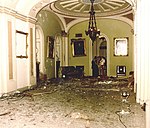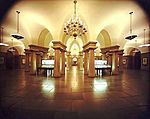United States Capitol dome

The United States Capitol features a dome situated above its rotunda. The dome is 288 feet (88 m) in height and 96 feet (29 m) in diameter. Designed by Thomas U. Walter, the fourth Architect of the Capitol, it was constructed between 1855 and 1866 at a cost of $1,047,291 (equivalent to $15.6 million in 2021).The dome is not stone, but rather cast iron carefully painted to appear to be made of the same stone as the main capitol building. It is actually two domes, one inside the other, and the total weight is 9.1 million pounds (4,100 t). The dome's cast iron frame was supplied and constructed by the iron foundry Janes, Fowler, Kirtland & Co. in the Bronx, New York. The dome marks the origin on street maps of Washington, D.C. A detailed look at the dome and its recent restoration can be found here.
Excerpt from the Wikipedia article United States Capitol dome (License: CC BY-SA 3.0, Authors, Images).United States Capitol dome
West Terraces and Steps, Washington
Geographical coordinates (GPS) Address Phone number Website Nearby Places Show on map
Geographical coordinates (GPS)
| Latitude | Longitude |
|---|---|
| N 38.89 ° | E -77.009 ° |
Address
United States Capitol
West Terraces and Steps
20534 Washington
District of Columbia, United States
Open on Google Maps







